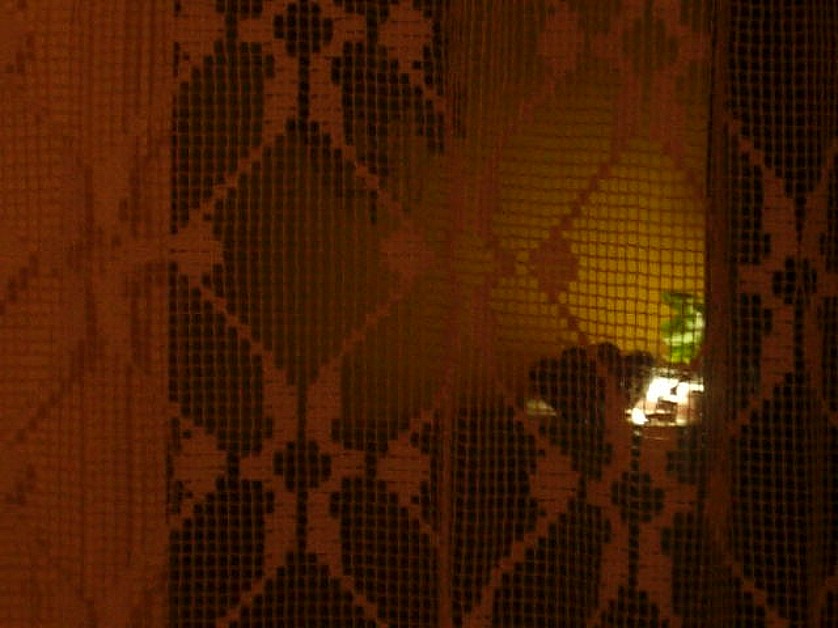Zahradní Ateliér / Garden Atelier
Giselle Eastman
Date of event:
10/12/06
Baton Rouge Gallery: Louisiana Sinfonietta
On the evening of October 12th was an event featuring the artwork of Vaclav Vaculovic and musicianship of violinist Zdenka Vaculicova and saxophonist Theofilos Sotiriades.
In comparison to the bright white space of the Baton Rouge Gallery, Vaculovic’s paintings were dark and fascinating, evoking images of mankind’s journey through life and into the afterlife. Each one depicted curiosity, struggle or fascination with the unknown, some moods accented with bright reds and greens and others expressed with muted browns, yellows.
Members of the Louisiana Sinfonietta under Dr. Dinos Constantinides performed Thursday evening with equal conviction. The program began with Anton Dvorak’s Notturno for String Orchestra, op. 40, a piece that ebbs and flows from the melancholy to the proud and joyous. The ensemble presented the piece with grace and passion.
Next was Brittle Relations, a piece composed by Peter Graham and featuring Zdenka Vaculicova on violin. Vaculicova’s tone quality is raw and passionate, a sound that cuts through the room and straight to your soul. Brittle Relations contains beautiful colors and sonorities that create a solid foundation to highlight the soloist’s talents. The acoustics in the gallery created a very exposed sound that was actually quite appropriate for this piece, and Vaculicova took that opportunity to seize the audience’s attention with her performance.
Third on the program came Grail: After the painting of Vaclav Vaculovic for String Orchestra from American composer Theodore Wiprud. Wiprud’s piece was stunning as played by the Sinfonietta musicians, sometimes filled with complex textures and tortured undercurrents, other times pensive and lyrical. The piece was a perfect complement to Vaculovic’s paintings, which expressed the same undulations and fascination with the unknown.
Last in the first half of the program was Karel Husa’s Four Little Pieces for String Orchestra. This piece, though not as technically demanding as some, contains much contrast and variety in both musicianship and technique. The orchestra used this as an opportunity to showcase their expressive abilities, perhaps one the most of the evening! The fast pieces were free and lighthearted and the slow were most solemn, leaving the audience breathless. Four Little Pieces ended boldly and densely, ending the first half of the program with confidence and anticipation for the second half.
After a brief intermission, the orchestra reassembled with Theofilos Sotiriades on soprano saxophone for the world premiere of Dinos Constantinides’ Landscape III for soprano saxophone and string orchestra. Sotiriades, a Greek musician and teacher who originally entered the world of music performing on guitar, introduced this work by Dr. Constantinides with grace and flare. The piece was filled with exposed parts as well as a building conversation between the orchestra and the unique timbre of the soprano saxophone. The first few minutes of the piece rose and fell like the sea, rushing forward and pulling back until finally allowing the saxophone to stand alone in a breathtaking solo. Sotiriades and the orchestra communicated well together, which is difficult with an instrument as dominating as the soprano saxophone.
The final piece of the evening was one of Czech composer Leos Janacek, Idyll for String Orchestra. Unlike the first piece in the program, Idyll was faster paced and finished out the evening in high spirits. The orchestra performed the piece playfully as it was quite dance-like in nature. The contrasting movements of the piece were colorful and accessible. The opening movement, especially, was filled with conversation between the sections and glorious textures and resonant lines and rhythms. The following movements pushed forward into the final section, which regally marched through the various motives with confidence and ended on a strong unison note.
Overall, the concert was very well-balanced and filled with variety. The soloists were standouts and were highlights of the evening. The program was complimentary to the artwork, even, as it explored many facets of music from the melancholy (like the approach to death) to the flowing (search for the afterlife) and onward to a reflection and then joy (much like the final two pieces, which rose above and uplifted the spirits of those listening). The Baton Rouge gallery was the perfect setting for such an intimate and memorable performance, as it allowed the audience to experience both the visual and aural aspects simultaneously. Bravo!




